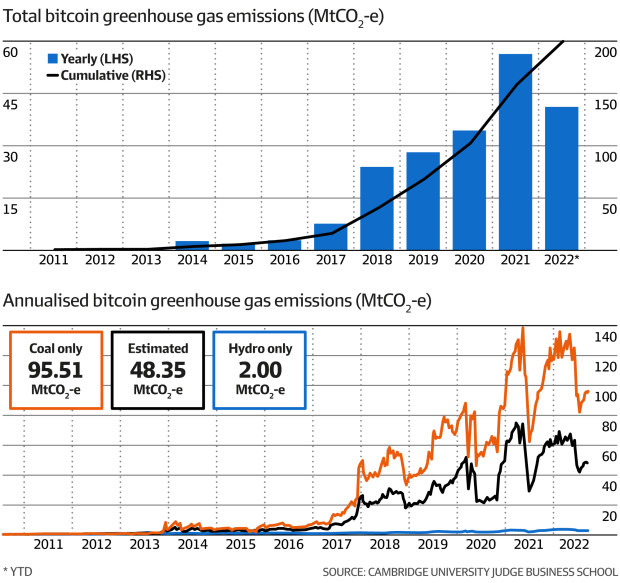Is Bitcoin’s energy use an environmental disaster

“With an electricity consumption of entire nations, and the international community’s much stronger commitment to intensifying decarbonization efforts to tackle climate change, Bitcoin appears at first glance to put these efforts at risk.”
Energy cost crisis
A separate University of New Mexico study published on September 30 estimated that bitcoin mining used more energy than Austria in 2020, as the European country rushes through emergency measures to help its citizens afford heating.

The US study led by Associate Professor of Economics Ben Jones estimated that bitcoin used 75.4 terawatt hours per year in 2020, which is higher than Austria’s 69.9 terawatt hours per year.
According to the peer-reviewed US research, each bitcoin mined under the proof-of-work method created 113 tons of carbon emissions in 2021, compared to less than one ton per coin in 2016. The polluting spillover effect increased in line with the amount of electricity the computer networks used used to mine coins during the period.
Bitcoin is power sick because it uses a proof-of-work consensus mechanism to verify transactions for miners to earn bitcoin.
In September, rival network Ethereum switched from its proof-of-work verification method to proof-of-stake, in a move that reportedly reduced the network’s energy consumption by around 99 percent.
In 2022, the European Parliament’s Committee on Economic and Monetary Affairs considered banning crypto-assets using proof-of-work in its flagship Markets in Crypto-Assets Regulation on the basis that it was incompatible with the targets for reducing carbon emissions in the Paris Agreement. However, it reversed its position, allegedly under lobbying by market players.
Bitcoin’s supporters have consistently denounced Ethereum’s conversion as crypto apostasy because proof-of-stake diminishes the decentralized, apolitical nature of digital asset networks.
Other major global regulators are less advanced in regulating digital assets and have generally chosen not to address the proof-of-stake versus proof-of-work debate.
In April 2021, with the digital coin trading at record highs of over US$63,000 ($97,300), Afterpay owner Square (now Block) and Cathie Wood-run investment manager Ark Invest published a white paper titled Bitcoin is the key to a future of abundant, clean energy.
The article argued that bitcoin mining provided an opportunity to accelerate the global energy transition to renewable energy sources as a complementary technology for clean energy production and storage.
Electric car maker Tesla bought bitcoin in early 2021 when its price rose and markets believed it was on the verge of widespread institutional adoption.
However, in August 2022, Tesla revealed that it had sold around 75 percent of its bitcoin holdings for $936 million at a significant loss. Founder Elon Musk said the decision was made for liquidity management.
The Cambridge research – backed by major governments, investment banks, payments giants and multilateral development organizations such as the IMF and the World Bank – estimated that bitcoin’s single largest power source came from coal at 36.6 percent in January 2022.
According to the research, hydropower was the largest sustainable energy source with a share of 14.9 per cent. Overall, it said fossil fuels accounted for 62.4 percent of the total electricity mix and sustainable energy sources 37.6 percent, comprising 26.3 percent renewable energy and 11.3 percent nuclear power.
The study noted that the findings contradict the July 2022 industry findings of the Bitcoin Mining Council, which estimated the share of sustainable energy sources in Bitcoin’s power mix was 59.5 percent.
























